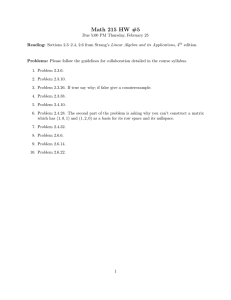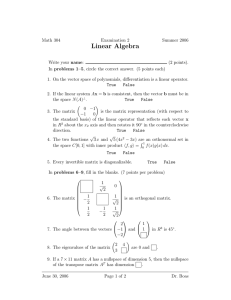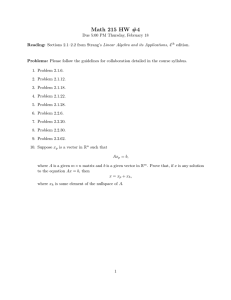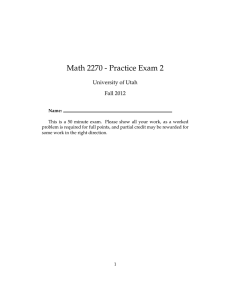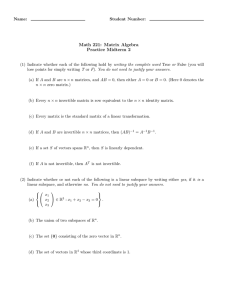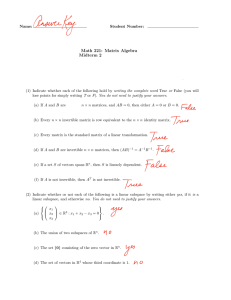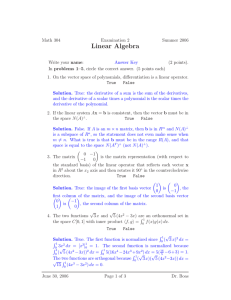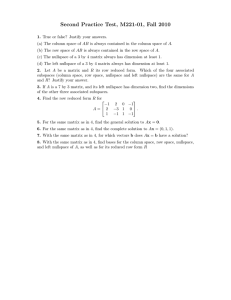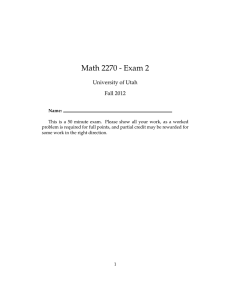Exam
advertisement
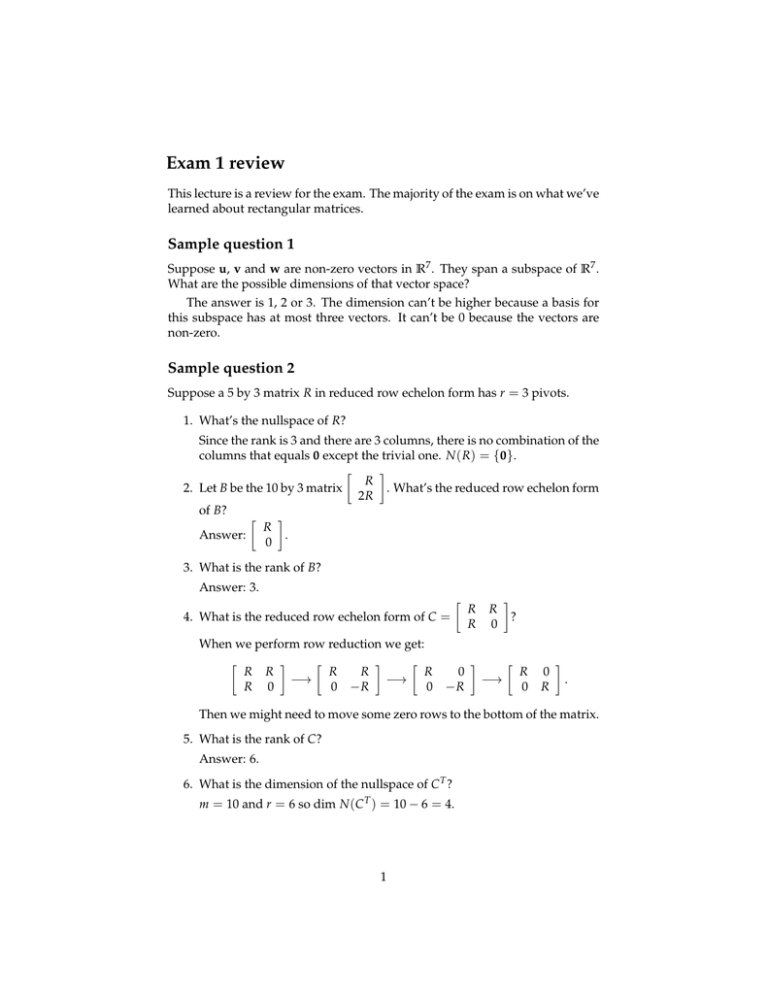
Exam 1 review
This lecture is a review for the exam. The majority of the exam is on what we’ve
learned about rectangular matrices.
Sample question 1
Suppose u, v and w are non-zero vectors in R7 . They span a subspace of R7 .
What are the possible dimensions of that vector space?
The answer is 1, 2 or 3. The dimension can’t be higher because a basis for
this subspace has at most three vectors. It can’t be 0 because the vectors are
non-zero.
Sample question 2
Suppose a 5 by 3 matrix R in reduced row echelon form has r = 3 pivots.
1. What’s the nullspace of R?
Since the rank is 3 and there are 3 columns, there is no combination of the
columns that equals 0 except the trivial one. N ( R) = {0}.
�
�
R
2. Let B be the 10 by 3 matrix
. What’s the reduced row echelon form
2R
of B?
�
�
R
Answer:
.
0
3. What is the rank of B?
Answer: 3.
�
4. What is the reduced row echelon form of C =
R
R
When we perform row reduction we get:
�
�
�
�
�
R R
R
R
R
−→
−→
R 0
0 −R
0
�
0
−R
R
0
�
?
�
−→
R
0
0
R
�
.
Then we might need to move some zero rows to the bottom of the matrix.
5. What is the rank of C?
Answer: 6.
6. What is the dimension of the nullspace of C T ?
m = 10 and r = 6 so dim N (C T ) = 10 − 6 = 4.
1
Sample question 3
�
Suppose we know that Ax =
2
4
2
�
and that:
⎡
⎤
⎡
⎤
⎡
⎤
2
1
0
x = ⎣ 0 ⎦+c⎣ 1 ⎦+d⎣ 0 ⎦
0
0
1
is a complete solution.
Note that in this problem we don’t know what A is.
1. What is the shape of the matrix A?
Answer: 3 by 3, because x and b both have three components.
2. What’s the dimension of the row space of A?
From the complete solution we can see that the dimension of the nullspace
of A is 2, so the rank of A must be 3 − 2 = 1.
3. What is A?
�
Because the second and third components of the particular solution
�
are zero, we see that the first column vector of A must be
�
Knowing that
0
0
1
1
2
1
2
0
0
�
�
.
�
is in the nullspace tells us that the third column of A
�
must be 0. The fact that
1
1
0
�
is in the nullspace tells us that the second
column must be the negative of the first.
⎡
1 −1
A = ⎣ 2 −2
1 −1
So,
⎤
0
0 ⎦.
0
If we had time, we could check that this A times x equals b.
4. For what vectors b does Ax = b have a solution x?
This equation has a solution exactly when b is in the column space of A,
� �
so when b is a multiple of
1
2
1
. This makes sense; we know that the
rank of A is 1 and the nullspace is large.
In contrast, we might have had r = m or r = n.
2
Sample question 4
Suppose:
⎡
⎤
−1
2
1 −1 ⎦ .
0
0
Try to answer the questions below without performing this matrix multi­
plication CD.
1
B = CD = ⎣ 0
1
1
1
0
⎤⎡
0
1 0
0 ⎦⎣ 0 1
1
0 0
1. Give a basis for the nullspace of B.
�
The matrix B is 3 by 4, so N ( B) ⊆ R4 . Because C =
1
0
1
1
1
0
0
0
1
�
is invertible, the nullspace of B is the same as the nullspace of D =
�
�
1
0
0
0
1
0
−1
1
0
2
−1
0
. Matrix D is in reduced form, so its special solutions
form a basis for N ( D ) = N ( B):
⎡
⎤ ⎡
⎤
1
−2
⎢ −1 ⎥ ⎢ 1 ⎥
⎢
⎥ ⎢
⎥
⎣ 1 ⎦,⎣ 0 ⎦.
0
1
These vectors are independent, and if time permits we can multiply to
check that they are in N ( B).
� �
2. Find the complete solution to Bx =
1
0
1
.
We can now describe any vector in the nullspace, so all we need to do is
find a particular solution. There are many possible particular solutions;
the simplest one is given below.
� �
� �
One way to solve this is to notice that C
�
vector x for which Dx =
first column of B = CD is
solution:
1
0
0
�
�
1
0
1
1
0
0
=
1
0
1
and then find a
. Another approach is to notice that the
�
. In either case, we get the complete
⎡
⎤
⎡
1
1
⎢ 0 ⎥
⎢ −1
⎢
⎥
⎢
x=⎣
+c⎣
0 ⎦
1
0
0
⎤
⎡
⎤
−2
⎥
⎢
⎥
⎥+d⎢ 1 ⎥.
⎦
⎣ 0 ⎦
1
Again, we can check our work by multiplying.
3
Short questions
There may not be true/false questions on the exam, but it’s a good idea to
review these:
1. Given a square matrix A whose nullspace is just {0}, what is the nullspace
of A T ?
N ( A T ) is also {0} because A is square.
2. Do the invertible matrices form a subspace of the vector space of 5 by 5
matrices?
No. The sum of two invertible matrices may not be invertible. Also, 0 is
not invertible, so is not in the collection of invertible matrices.
3. True or false: If B2 = 0, then it must be true that B = 0.
�
�
0 1
False. We could have B =
.
0 0
4. True or false: A system Ax = b of n equations with n unknowns is solv­
able for every right hand side b if the columns of A are independent.
True. A is invertible, and x = A−1 b is a (unique) solution.
5. True or false: If m = n then the row space equals the column space.
False. The dimensions
are� equal, but the spaces are not. A good example
�
0 1
to look at is B =
.
0 0
6. True or false: The matrices A and − A share the same four spaces.
True, because whenever a vector v is in a space, so is −v.
7. True or false: If A and B have the same four subspaces, then A is a multi­
ple of B.
A good way to approach this question is to first try to convince yourself
that it isn’t true – look for a counterexample. If A is 3 by 3 and invertible,
then its row and column space are both R3 and its nullspaces are {0}. If B
is any other invertible 3 by 3 matrix it will have the same four subspaces,
and it may not be a multiple of A. So we answer “false”.
It’s good to ask how we could truthfully complete the statement “If A
and B have the same four subspaces, then ...”
8. If we exchange two rows of A, which subspaces stay the same?
The row space and the nullspace stay the same.
4
�
9. Why can’t a vector v =
1
2
3
�
be in the nullspace of A and also be a row
of A?
Because if v is the nth row of A, the nth component of the vector Av
would be 14, not 0. The vector v could not be a solution to Av = 0.
In fact, we will learn that the row space is perpendicular to the nullspace.
5
MIT OpenCourseWare
http://ocw.mit.edu
18.06SC Linear Algebra
Fall 2011
For information about citing these materials or our Terms of Use, visit: http://ocw.mit.edu/terms.
